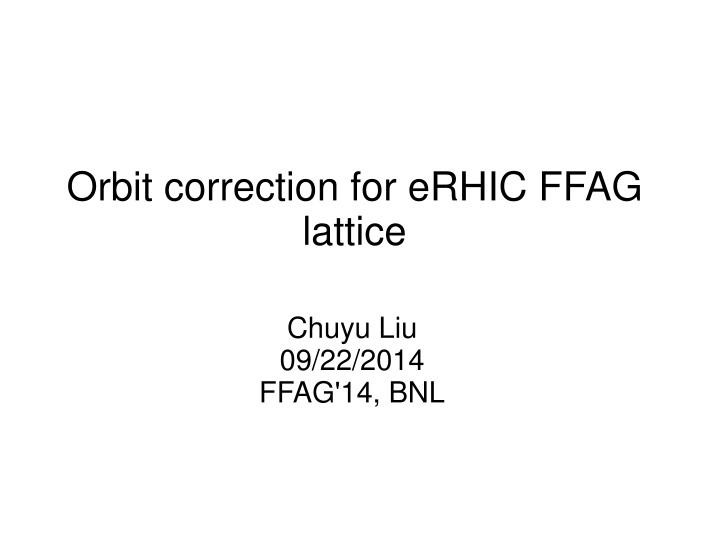
Orbit Correction Challenges in eRHIC FFAG Lattice
Explore the unique challenges in correcting orbits within the eRHIC FFAG design, where multiple beams of varying energies require specialized correction strategies for optimal performance and beam alignment. Learn about the orbit correction strategy and the impact of lattice errors on orbit distortion in this comprehensive study.
Download Presentation

Please find below an Image/Link to download the presentation.
The content on the website is provided AS IS for your information and personal use only. It may not be sold, licensed, or shared on other websites without obtaining consent from the author. If you encounter any issues during the download, it is possible that the publisher has removed the file from their server.
You are allowed to download the files provided on this website for personal or commercial use, subject to the condition that they are used lawfully. All files are the property of their respective owners.
The content on the website is provided AS IS for your information and personal use only. It may not be sold, licensed, or shared on other websites without obtaining consent from the author.
E N D
Presentation Transcript
Orbit correction for eRHIC FFAG lattice Chuyu Liu 09/22/2014 FFAG'14, BNL
Outline Introduction Orbits with lattice errors Orbit correction Orbit response Summary
eRHIC FFAG eRHIC consists two FFAG rings for electron beam, respectively 6 and 11 passes
Orbits in eRHIC FFAG ~31 mm ~12 mm
Why is orbit correction challenging? The unique feature of the orbits in the eRHIC FFAG design is that multiple accelerating and decelerating bunches pass through the same magnets with different horizontal offsets for beams of various energies, except in the spreaders and combiners where the beams are in separate vacuum chambers. In the FFAG accelerator, the beams of different energies respond differently to dipole correctors due to the energy-dependent tune. As a result, correction of one orbit will not improve other orbits passing through the same lattice. Therefore, dipole errors must be locally compensated to correct multiple orbits simultaneously. It is challenging and critical for eRHIC FFAG to correct orbit errors for better spin transparency and alignment of colliding beams.
Orbit correction strategy H dipole trims and V dipole trims are situated at focusing and de-focusing quadrupoles respectively; quadrupole trims are situated at each and every quadrupole center. There is 1 BPM per 3 FFAG cells for position measurements. Beam positions of all available passes will be corrected simultaneously.
Orbit distortion due to misalignment For simulation
Cont'd Magnification factor = (Orbit distortion rms)/(Misalignment rms) Magnification factors are in a reasonable range Simulation agree with theoretical approximation
Orbit distortion due to gradient error For simulation Goal
Correcting first pass 1 2 3 4 5 6 7 8 9 2nd pass improved
Orbit response All simulations presented so far are based on the model orbit response, if the response deviate from the model (for example, due to gradient errors), then one can not reduce the orbit rms down to < 1 mm.
Sources for orbit response deviation Gradient errors change orbit response, which is the basis for determining gradient errors using ORM (orbit response measurement). Beam energy offset (because of initial energy offset, energy gain offset or synchrotron radiation) cause deviation of orbit response. The decoherence due to chromacitity would affect the measured beam position and orbit response as well.
Chromaticities E (GeV) 7.944 9.266 10.588 11.91 13.232 14.554 15.876 17.198 18.52 19.842 21.164 H chrom -598.9 -356.2 -271.2 -223.9 -192.8 -170.3 -153.1 -139.5 -128.3 -119.0 -111.1 V chrom -402.2 -300.5 -246.6 -212.7 -189.5 -173.1 -161.6 -154.3 -151.1 -153.0 -163.4 H phase smear ( ) V phase smear( ) -1.20 -0.71 -0.54 -0.45 -0.39 -0.34 -0.30 -0.28 -0.26 -0.24 -0.22 -0.80 -0.60 -0.49 -0.43 -0.38 -0.35 -0.32 -0.31 -0.30 -0.31 -0.33 Orbit response will deviate strongly due to decoherence for low energy passes in HE ring.
Orbit response from multi-particle tracking Phase space at observation point Inital phase space Measured beam position (red +) deviate substantially from the on-momentum particle position (green dot).
Is orbit response still linear? Orbit response of a bunch is smaller than that of the on-momentum particle, still linear!
Summary Orbit correction is challenging and critical for eRHIC FFAG. Two main sources for orbit deviation are misalignments and gradient errors. Simultaneous correction of the multi-pass orbits was proposed and demonstrated. Orbit response deviation is expected, especially due to decoherence, however, the orbit response is still linear. Orbit correction will rely on a simulation or precise measurement of orbit response.
